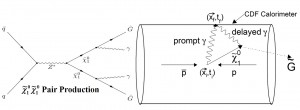Greetings Quantum Diaries World!
Well, after a little bit of delay I’ve finally gotten the go ahead to begin to do some blogging about my life and times at Fermilab and the greater Chicago area. I do hope to fill this blog with all of the great experiences and people that I am privileged to while I spend my days trying to finish my PhD in particle physics. While I doubt my experience is in any way unique to the many graduate students that have seen their ways through Fermilab, I don’t think many of them have had the chance to share them in this format with the world outside their own community.
Research
So I feel I should start the blogging process with a quick explanation of the research I do here at Fermilab. I am a graduate student with Texas A&M University working on the Collider Detector at Fermilab (CDF), the best experiment in all the land (my humble opinion) !

Texas A&M's Delayed Photon CDF team
Texas A&M’s group is involved in many different activities on CDF, but the portion I am involved with does searches for new physics being created based on looking for odd signatures not predicted by our current model of particle physics.
Specifically, the research I’m involved in looks for events using photons (the particle of light). Photons are the second most frequently created object at Fermilab (right behind jets) so in principle this gives us a lot of events to look at. However, we aren’t looking for just any old kind of photon. In many models of new physics you would notice their signature by virtue of the photons arriving ‘delayed’ in time (relative to other objects in the event).
This idea is admittedly a little weird and in order to get a handle of things we’ve had to do a lot of non-standard things. Most notably, Texas A&M’s group was involved with the installation and are currently the lead maintainers of a system unique to CDF known as EMTiming. The EMTiming system allows us to get a time signature on the different objects in our events with about 0.5 nanosecond resolution. What this means is we know to a real high precision when in time the objects arrived at our detectors. When we compare this to how fast we would expect the objects to arrive from the collision point we can start to ask the question, “Is there anything new / different here?”

An example of "New Physics" that would have a delayed time signature in our EMTiming system
The example I show in the image here is an example of Gauge Mediated Supersymmetry Breaking (GMSB) model that if our collisions in the accelerator were creating this interaction than you would start to see a ‘delayed’ photon arriving in our detector. Our EMTiming system allows us to be sensitive to this type of new physics. What is truly amazing about this type of signature based search is that you aren’t limited to looking at one model of new physics. Instead you are sensitive to all sorts of new physics since all you care about is looking for something weird in your data.
Now this is a very simplified view of the type of research that we do and obviously there is much more care taken to defining everything and modeling the physics then what I care to describe right now. However, if you have questions or want to learn more I would encourage you to leave a comment or shoot me an email and I love talking about this wacky physics we do at Texas A&M. As just a side note our group (and collaboration) currently holds the world’s best limit on GMSB models. As shown in the image below, the most recent search completed by Eunsin Lee of Texas A&M has extended our limits on the mass and lifetime of the Next to Lightest Super Particle (NLSP) in many GMSB models known as the Neutralino. Basically, WE ROCK, and if there is new physics to find using delayed photons I am sure that our group and CDF will be the ones to hammer it out!

The most recent results blessed showing the region of parameter space excluded by our searches for new physics at CDF